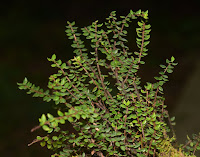 |
| Agapetes huangiana Bin Yang, Y.H.Tan & Y.H.Tong, in Yang, Ya, Tong, Wang, ... et Tan, 2022. 素华树萝卜 || facebook.com/TaiwaniaOffice |
Abstract
Agapetes huangiana Bin Yang, Y.H.Tan & Y.H.Tong (Ericaceae) is described and illustrated as a new species endemic to Xizang, China. It is morphologically similar to A. guangxiensis D. Fang and A. epacridea Airy Shaw, but clearly differs in having thinly leathery leaf blades with verrucose-scabrid trichomes abaxially, shorter pedicel, and densely white-puberulent calyx and corolla.
Keyword: Agapetes epacridea, A. guangxiensis, floristic exploration, Mêdog, morphology, Taxonomy

 |
| Morphological comparison among Agapetes huangiana (A-B), A. epacridea (C-D) and A. guangxiensis (E-F). (Photos: A, D by B. Yang, B by R.P. Zhang, C by Y.H. Tan, E by F.M. Yang, F by Y.H. Tong). |
Agapetes huangiana Bin Yang, Y.H.Tan & Y.H.Tong, sp. nov.
Diagnosis: Agapetes huangiana is morphologically similar to A. guangxiensis and A. epacridea in having spirally alternate leaves with short pedicels and ovate blades, and branchlets densely covered with spreading setae, but can be clearly distinguished from the former by its smaller leaf blades (5–8 × 3–6 mm vs. 7–14 × 4–9 mm), leaf blades verrucose-scabrid (vs. glabrous) abaxially, midvein and secondary veins inconspicuous (vs. conspicuous, Fig. S1F), leaf blade margin almost entire with unconspicuous glandular teeth (vs. with glandular spiny serration, Fig. S1F), much shorter pedicel (1.0–1.5 mm vs. ca. 5 mm), and white-puberulent (vs. hirstute) pedicel and calyx; and from the latter by its thinly leathery (vs. thickly leathery) leaf blades with apiculate apices (vs. with 1–1.5 mm long pungent mucros, Fig. S1C & D), shorter (11–12 mm vs. 19–20 mm) and pure white corolla tube without coloured lines (vs. with five fine red vertical lines, Fig. S1C), shorter filaments (5–6 mm vs. 11.5–13.0 mm) and anthers without spurs dorsally (vs. with 2 spurs) (Table 1).
Distribution and habitat: Agapetes huangiana is
known only from Beibeng Township of Mêdog County,
in Southeast Xizang, Southwest China. It is usually
epiphytic on the trees of subtropical evergreen broadleaved forest at elevations of 1390–2100 m.
Etymology: The specific epithet is named in honor of
Prof. Su-Hua Huang (1938–2020), a female botanist in
Yunnan University, who has made great contributions to
the taxonomic study of Agapetes in China (Huang, 1983,
1987, 1991; Huang et al., 1998).
Vernacular: 素华树萝卜
Bin Yang, Ji-Dong Ya, Yi-Hua Tong, Ping-Yuan Wang, Cheng Liu, Wang-Lin Zhao, Zhen Liu and Yun-Hong Tan. 2022. Agapetes huangiana (Ericaceae), A New Species from Southeast Xizang, China. Taiwania. 67(2); 254-259. DOI: 10.6165/tai.2022.67.254






